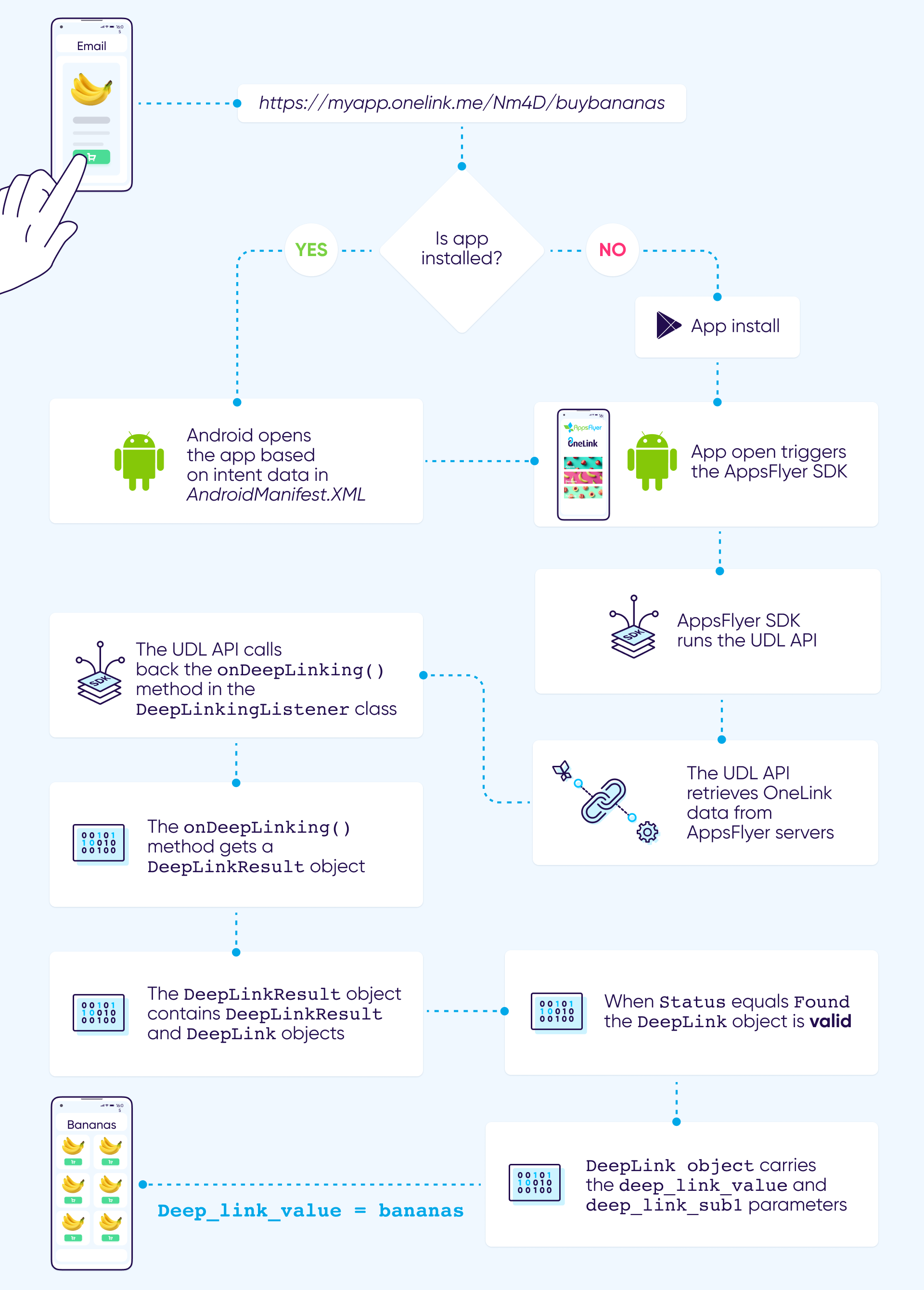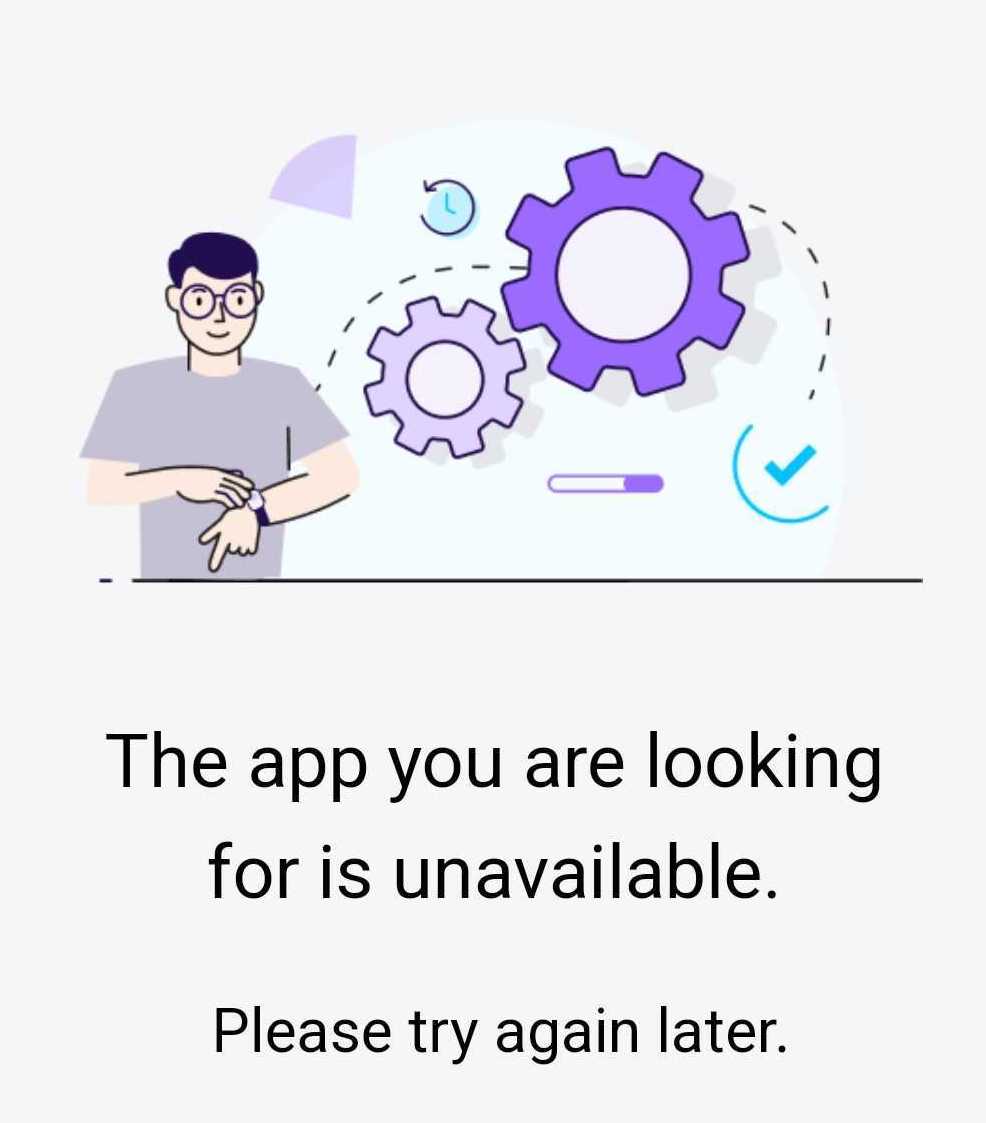Android Unified Deep Linking
At a glance: Unified deep linking (UDL) enables you to send new and existing users to a specific in-app activity (for example, a specific page in the app) as soon as the app is opened.
UDL privacy protection
For new users, the UDL method only returns parameters relevant to deferred deep linking:
deep_link_valueanddeep_link_sub1-10. If you try to get any other parameters (media_source,campaign,af_sub1-5, etc.), they return null.
Flow

The flow works as follows:
- User clicks a OneLink link.
- If the user has the app installed, the Android App Links or URI scheme opens the app.
- If the user doesn't have the app installed, they are redirected to the app store, and after downloading, the user opens the app.
- The app open triggers the AppsFlyer SDK.
- The AppsFlyer SDK runs the UDL API.
- The UDL API retrieves OneLink data from AppsFlyer servers.
- The UDL API calls back the
onDeepLinking()method in theDeepLinkingListenerclass. - The
onDeepLinking()method gets aDeepLinkResultobject. - The
DeepLinkResultobject includes:- Status (Found/Not found/Error)
- A DeepLink object that carries:
- For users with app not yet installed: The
deep_link_valueanddeep_link_sub1-10parameters. - For users with the app already installed:The
deep_link_valueanddeep_link_sub1-10parameters and all parameters contained in thelinkparameter of the OneLink attribution link.
- For users with app not yet installed: The
Planning
- UDL requires AppsFlyer Android SDK V6.1+.
When setting up OneLinks, the marketer uses parameters to create the links, and the developer customizes the behavior of the app based on the values received. It's the developer's responsibility to make sure the parameters are handled correctly in the app, for both in-app routing, and personalizing data in the link.
To plan the OneLink:
- Get from the marketer the desired behavior and personal experience a user gets when they click the URL.
- Based on the desired behavior, plan the
deep_link_valueand other parameters that are needed to give the user the desired personal experience.- The
deep_link_valueis set by the marketer in the URL and used by the developer to redirect the user to a specific place inside the app. For example, if you have a fruit store and want to direct users to apples, the value ofdeep_link_valuecan beapples. - The
deep_link_sub1-10parameters can also be added to the URL to help personalize the user experience. For example, to give a 10% discount, the value ofdeep_link_sub1can be10.
- The
Implementation

Let's save you some time >>
Set Deep Linking with our SDK integration wizard
Implement the UDL API logic based on the chosen parameters and values.
- Use the
subscribeForDeepLink()method (fromAppsFlyerLib), before calling start, to register theDeepLinkListenerinterface listener. - Make sure you override the callback function
onDeepLinking().
onDeepLinking()accepts as an argument aDeepLinkResultobject. - Use
getStatus()to query whether the deep linking match is found. - For when the status is an error, call
getError()and run your error flow. - For when the status is found, use
getDeepLink()to retrieve theDeepLinkobject.
TheDeepLinkobject contains the deep linking information and helper functions to easily retrieve values from well-known OneLink keys, for example,getDeepLinkValue(). - Use
getDeepLinkValue()to retrieve thedeep_link_value. - Use
getStringValue("deep_link_sub1")to retrievedeep_link_sub1. Do the same fordeep_link_sub2-10parameters, changing the string value as required. - Once
deep_link_valueanddeep_link_sub1-10are retrieved, pass them to an in-app router and use them to personalize the user experience.
Note
onDeepLinkingis not called when the app is running in the background and Application LaunchMode is not standard.
To correct this, callsetIntent(intent)method to set the intent value inside the overridden methodonNewIntentif the application is using a non-standard LaunchMode.import android.content.Intent; ... ... ... @Override protected void onNewIntent(Intent intent) { super.onNewIntent(intent); setIntent(intent); }
Supporting legacy OneLink links
Legacy OneLink are links that don't contain the parameters recommended for UDL: deep_link_value and deep_link_sub1-10.
Usually these are links that already exist and are in use when migrating from legacy methods to UDL.
News users using legacy links are handled by onConversionDataSuccess in the context of Extended Deferred Deep Linking.
UDL handles deep linking for existing users. In this case, it's recommended to add support in the UDL callback onDeepLinking for legacy parameters.
Java code example
Code example
appsflyer.subscribeForDeepLink(new DeepLinkListener
@Override
public void onDeepLinking(@NonNull DeepLinkResult deepLinkResult) {
DeepLinkResult.Status dlStatus = deepLinkResult.getStatus();
if (dlStatus == DeepLinkResult.Status.FOUND) {
Log.d(LOG_TAG, "Deep link found");
} else if (dlStatus == DeepLinkResult.Status.NOT_FOUND) {
Log.d(LOG_TAG, "Deep link not found");
return;
} else {
// dlStatus == DeepLinkResult.Status.ERROR
DeepLinkResult.Error dlError = deepLinkResult.getError();
Log.d(LOG_TAG, "There was an error getting Deep Link data: " + dlError.toString());
return;
}
DeepLink deepLinkObj = deepLinkResult.getDeepLink();
try {
Log.d(LOG_TAG, "The DeepLink data is: " + deepLinkObj.toString());
} catch (Exception e) {
Log.d(LOG_TAG, "DeepLink data came back null");
return;
}
// An example for using is_deferred
if (deepLinkObj.isDeferred()) {
Log.d(LOG_TAG, "This is a deferred deep link");
} else {
Log.d(LOG_TAG, "This is a direct deep link");
}
// ** Next if statement is optional **
// Our sample app's user-invite carries the referrerID in deep_link_sub2
// See the user-invite section in FruitActivity.java
if (dlData.has("deep_link_sub2")){
referrerId = deepLinkObj.getStringValue("deep_link_sub2");
Log.d(LOG_TAG, "The referrerID is: " + referrerId);
} else {
Log.d(LOG_TAG, "deep_link_sub2/Referrer ID not found");
}
// An example for using a generic getter
String fruitName = "";
try {
fruitName = deepLinkObj.getDeepLinkValue();
Log.d(LOG_TAG, "The DeepLink will route to: " + fruitName);
} catch (Exception e) {
Log.d(LOG_TAG, "Custom param fruit_name was not found in DeepLink data");
return;
}
goToFruit(fruitName, deepLinkObj);
}
});
AppsFlyerLib.getInstance().subscribeForDeepLink(object : DeepLinkListener{
override fun onDeepLinking(deepLinkResult: DeepLinkResult) {
when (deepLinkResult.status) {
DeepLinkResult.Status.FOUND -> {
Log.d(
LOG_TAG,"Deep link found"
)
}
DeepLinkResult.Status.NOT_FOUND -> {
Log.d(
LOG_TAG,"Deep link not found"
)
return
}
else -> {
// dlStatus == DeepLinkResult.Status.ERROR
val dlError = deepLinkResult.error
Log.d(
LOG_TAG,"There was an error getting Deep Link data: $dlError"
)
return
}
}
var deepLinkObj: DeepLink = deepLinkResult.deepLink
try {
Log.d(
LOG_TAG,"The DeepLink data is: $deepLinkObj"
)
} catch (e: Exception) {
Log.d(
LOG_TAG,"DeepLink data came back null"
)
return
}
// An example for using is_deferred
if (deepLinkObj.isDeferred == true) {
Log.d(LOG_TAG, "This is a deferred deep link");
} else {
Log.d(LOG_TAG, "This is a direct deep link");
}
try {
val fruitName = deepLinkObj.deepLinkValue
Log.d(LOG_TAG, "The DeepLink will route to: $fruitName")
} catch (e:Exception) {
Log.d(LOG_TAG, "There's been an error: $e");
return;
}
}
})
⇲ Github links: Java
Testing deferred deep linking
Prerequisites
- Complete UDL integration
- Register your testing device
- Enable debug mode in the app
- Make sure the app isn't installed on your device
- Ask your marketer for a OneLink template.
- It will look something like this:
https://onelink-basic-app.onelink.me/H5hv. - This example uses the OneLink subdomain
onelink-basic-app.onelink.meand the OneLink template IDH5hv
- It will look something like this:
The test link
You can use an existing OneLink link or ask your marketer to create a new one for testing. Both short and long OneLink URLs can be used.
Adding ad-hoc parameters to an existing link
- Use only the domain and OneLink template of your link, for example:
https://onelink-basic-app.onelink.me/H5hv. - Add OneLink parameters
deep_link_valueanddeep_link_sub1-10, as expected by your application. The parameters should be added as query parameters.- Example:
https://onelink-basic-app.onelink.me/H5hv?pid=my_media_source&deep_link_value=apples&deep_link_sub1=23
- Example:
Perform the test
- Click the link on your device.
- OneLink redirects you according to the link setup, either to Google Play or a website.
- Install the application.
Important
- If the application is still in development, and not uploaded to the store yet, you see this image:

- Install the application from Android Studio or any other IDE you use.
- If the application is still in development, and not uploaded to the store yet, you see this image:
- UDL detects the deferred deep linking, matches the install to the click and retrieves the OneLink parameters to
onDeepLinkingcallback.
Expected logs results
The following logs are available only when debug mode is enabled.
-
SDK initialized:
D/AppsFlyer_6.9.0: Initializing AppsFlyer SDK: (v6.9.0.126) -
The following log refers to direct deep linking, and can be ignored in a deferred deep linking scenario:
D/AppsFlyer_6.9.0: No deep link detected -
UDL API starts:
D/AppsFlyer_6.9.0: [DDL] start -
UDL sends query to AppsFlyer to query a match with this install:
D/AppsFlyer_6.9.0: [DDL] Preparing request 1 ... I/AppsFlyer_6.9.0: call = https://dlsdk.appsflyer.com/v1.0/android/com.appsflyer.onelink.appsflyeronelinkbasicapp?af_sig=<>&sdk_version=6.9; size = 239 bytes; body = { ... TRUNCATED ... } -
UDL got a response and calls
onDeepLinkingcallback withstatus=FOUNDand OneLink link data:D/AppsFlyer_6.9.0: [DDL] Calling onDeepLinking with: {"deepLink":"{\"campaign_id\":\"\",\"af_sub3\":\"\",\"match_type\":\"probabilistic\",\"af_sub1\":\"\",\"deep_link_value\":\"apples\",\"campaign\":\"\",\"af_sub4\":\"\",\"timestamp\":\"2022-12-06T11:47:40.037\",\"click_http_referrer\":\"\",\"af_sub5\":\"\",\"media_source\":\"\",\"af_sub2\":\"\",\"deep_link_sub1\":\"23\",\"is_deferred\":true}","status":"FOUND"}
Testing deep linking (Android App Links)
Prerequisites
- Complete UDL integration
- Register your testing device
- Enable debug mode in the app
- Make sure the app is already installed on your device
- Ask your marketer for a OneLink template.
- It will look something like this
https://onelink-basic-app.onelink.me/H5hv. - This example uses the OneLink subdomain
onelink-basic-app.onelink.meand the OneLink template IDH5hv.
- It will look something like this
- Configure Android App-Links.
Create the test link
Use the same method as in deferred deep linking.
Perform the test
- Click the link on your device.
- UDL detects the Android App Link and retrieves the OneLink parameters to
onDeepLinkingcallback.
Expected logs results
The following logs are available only when debug mode is enabled.
- If the link is a OneLink shortlink (e.g. https://onelink-basic-app.onelink.me/H5hv/apples)
D/AppsFlyer_6.9.0: HTTP: [258990367] GET:https://onelink.appsflyer.com/shortlink-sdk/v2/H5hv?id=apples - UDL calls
onDeepLinkingcallback withstatus=FOUNDand OneLink link dataD/AppsFlyer_6.9.0: [DDL] Calling onDeepLinking with: {"deepLink":"{\"path\":\"\\\/H5hv\",\"scheme\":\"https\",\"link\":\"https:\\\/\\\/onelink-basic-app.onelink.me\\\/H5hv?deep_link_value=apples&deep_link_sub1=23\",\"host\":\"onelink-basic-app.onelink.me\",\"deep_link_sub1\":\"23\",\"deep_link_value\":\"apples\",\"is_deferred\":false}","status":"FOUND"}
Tip
If when clicking an Android App Link the OS shows a Disambiguation Dialog or redirects to Google Play or a website, check whether the SHA256 signature is correct.
- Use
adbto get the app signature on the device:adb shell pm get-app-links <PACKAGE_NAME>-2. Make sure the subdomain is
verified.
- If the subdomain isn't verified, it shows
1024.
Updated about 2 months ago

